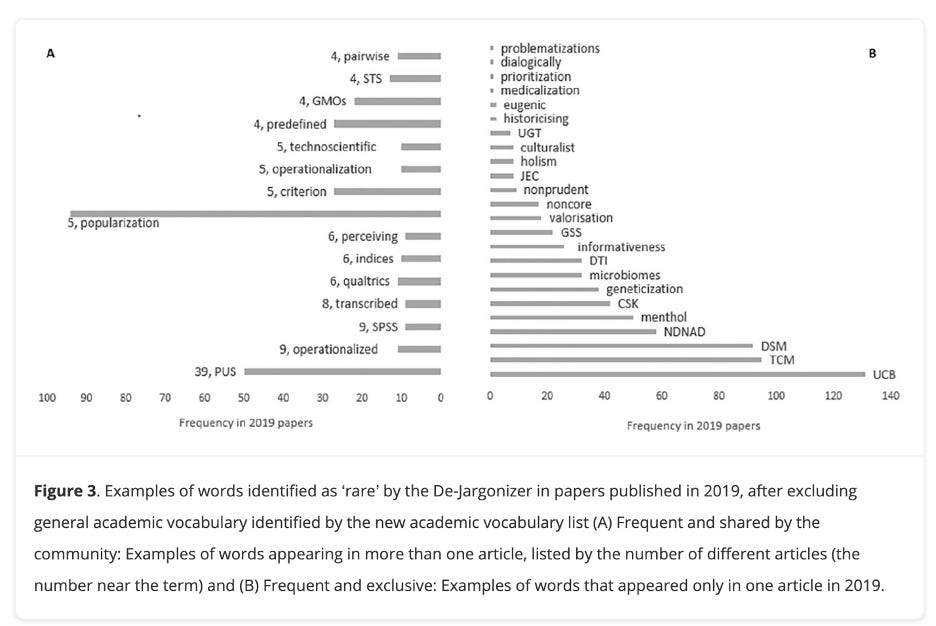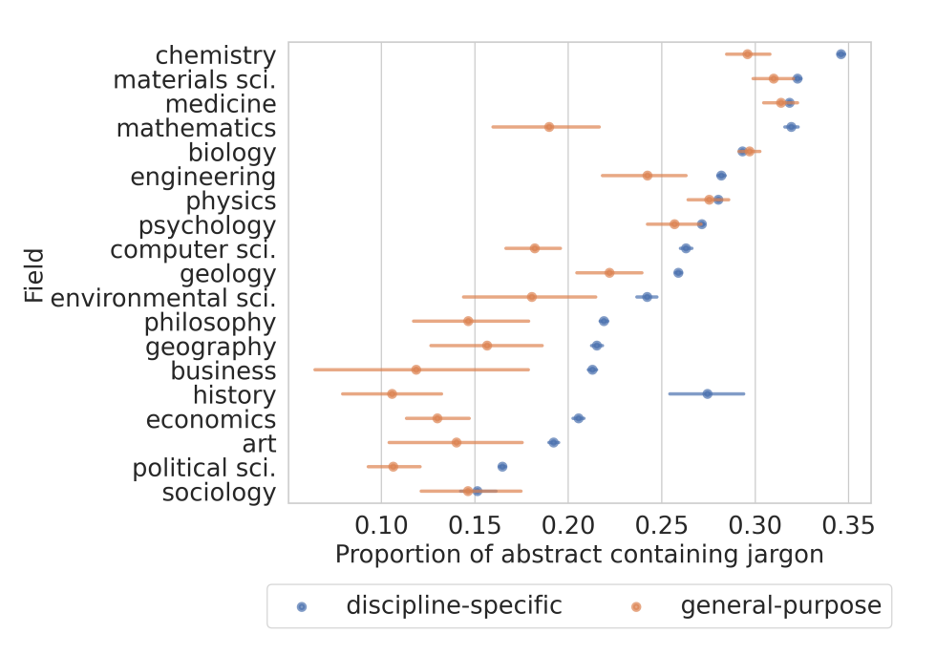How does jargon impact interdisciplinary collaboration?
Jargon use may be rising, which may be impeding interdisciplinary work. Can AI help?
Image Source: ThoughtCo
Language and terminology can impede or promote research impact. “Jargon” – technical or specialist terminology that general audiences outside of a group do not understand – is generally recognized as a barrier to effective research communication. But jargon is still everywhere in academic research and notoriously difficult to combat.
Studies from a variety of disciplines demonstrate how overly technical language impedes public communication of science. But there is limited examination of how interdisciplinary teams, who often communicate through distinctive sets of terminologies, are specifically affected by and navigate the use of technical language.
This post, part of the living literature review on interdisciplinary research, discusses the state of research on these issues. Identifying emerging knowledge on jargon’s impacts on forms of transdisciplinary, interdisciplinary, and multidisciplinary research, it also reviews available analysis on strategies to address jargon use, including emergent AI tools.
Is Jargon on the rise?
Although studies are limited, there is some indication that jargon use is increasing. Barnett and Doubleday, 2020 and Plaven-Sigray et al, 2017 track jargon use rises with increasing scientific specialization. The theory is that with increased specialism, scholars increase their use of specialist vocabulary.
But specialization may not be the only factor driving jargon use. Some studies suggest that academics are increasing their use of jargon over time more generally, which may indicate a decline in scholarship’s overall accessibility.
Definitively tracking this is difficult, as there are not available cross-disciplinary, meta analysis to track change over time with clear metrics. Offering one view, Baram-Tsabari et al, 2020 observe an increase in the use of jargon in the interdisciplinary journal Public Understanding of Science, aimed at scholars and practitioners. Reviewing three decades of the journal, they reviewed articles published in 1999/2000 (47), 2009 (49), and 2019 (65) using the “de-jargonizer”, a free open source service (scienceandpublic.com) that classifies each word into high, medium or rare frequency. They find that the use of jargon has increased over time, reducing the accessibility of papers. They find that “rare words” they identify (see their Figure 3, copied below, for examples) are sometimes so specialist that they appear in only one article. They conclude that the journal has “moved away from everyday language,” suggesting negative implications for the accessibility of research.
(Source: Baram-Tsabari et al, 2020)
How does jargon shape interdisciplinary research?
If there is an increase in jargon use among scholars, what does this mean for interdisciplinary research? Scholarship seems clear that research communication requires a shared vocabulary. Strober, 2006 identifies that work to align on a shared vocabulary is a building block for multidisciplinary engagement, and how without it, engagement between scholars of different fields is limited. Lucy et al, 2022, and Choi and Pak, 2007 frame words as “gatekeepers” for effective research communication, identifying unique terminologies within different scientific domains that can optimize communication within the field, but impedes communication and collaboration with researchers in other domains.
Lucy et al (2022) suggest that jargon use may be reducing not just the interdisciplinary production but also the consumption of research in multiple disciplines. Their study of discipline-specific terms as well as terms that hold different meanings across fields determines that jargon use is “nearly always” negatively correlated with interdisciplinary impact. They observe jargon use to be highest in the natural and hard sciences, and lowest in the social sciences (Figure 2 below) They find that abstracts in the same field typically contain less jargon in venues for wider generalist audiences (e.g. Nature) than when they are in discipline-focused ones (e.g. Genetics). They find that, “though multidisciplinary venues intend to cater to more general audiences, some fields' writing norms may act as barriers rather than bridges, and thus impede the dispersion of scholarly ideas.”
Source: Lucy et al 2022
Taguchi and Boden (2025) go further to suggest that jargon can even impede innovation, finding in a study of an interdisciplinary children’s education program that when jargon is automatized and internalized, it can hold the participating scholars back from meta-reflection and creativity.
Jargon: What can be done?
Scholars and technologists have developed a variety of tools that may help researchers identify and reduce jargon use, which could potentially enhance interdisciplinary collaboration and research use across multiple disciplines, increasing interdisciplinary impact.
Shi et al. (2018) offer a methodology, using neural language modeling, to pinpoint terms whose meanings drastically differ across fields, helping scholars highlight vocabulary that could confuse interdisciplinary collaborators. Willoughby et al (2020) offer an R script, published for public access, that scholars can use to quantify the amount of scientific jargon in their writing.
Can AI help?
Artificial Intelligence (AI) provides hope for bridging scholarly divides if scholars harness tools to identify and reduce jargon use.
Natural language techniques are being used to identify and simplify scholarly jargon (Gardner and Davies, 2013; Tanaka-Ishii and Terada, 2011). Guo et al 2025 recommend personalizing this process, highlighting the risk of identifying false positives and offering suggestions for training models to accurately detect jargon. There is a push, for example, to deploy these AI tools to reduce jargon in the medical field, to improve patient communication, with some promising models in improved patient care.
--
Jargon is not all bad news – when appropriately deployed, it can improve the efficiency of communication within specialized groups, can help convey complex ideas, signal expertise, and can improve intra-group community building.
But research seems to indicate its use – which may be increasing over time – is an impediment to interdisciplinary collaboration. With indication that interdisciplinary research is not necessarily rising as hoped (the subject of another post), investment in the identification and reduction of jargon use in research publications, and tools to help cross-disciplinary teams combat it, could bring benefits for scholarly collaborations.
This post is part of a living literature review on interdisciplinary research, Bridging Boundaries. Learn more about the project here.





